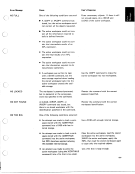ARRANGING THE OUTPUT FROM A
USER-DEFINED FUNCTION
The output from user-defined functions can be arranged by using the format func-
tion (see the v function in Chapter 4) or bare output. Bare output is discussed
next.
Bare Output
After normal output, the cursor is moved to the next line so that the next entry
(either input or output) will begin at a standard position. However, bare output,
denoted by the form m+X (X can be
any expression), does not move the cursor
to the next line. Therefore, more than one variable or expression can be displayed
on the same line. For example:
Since the cursor does not return to the next line after bare output, when quad
quote (1) input is entered following the bare output, the input starts after the
last character of the bare output. Then when the input is processed, it is pre-
fixed by any bare output on the input line. For example:
146
USER-DEFINED FUNCTION
The output from user-defined functions can be arranged by using the format func-
tion (see the v function in Chapter 4) or bare output. Bare output is discussed
next.
Bare Output
After normal output, the cursor is moved to the next line so that the next entry
(either input or output) will begin at a standard position. However, bare output,
denoted by the form m+X (X can be
any expression), does not move the cursor
to the next line. Therefore, more than one variable or expression can be displayed
on the same line. For example:
Since the cursor does not return to the next line after bare output, when quad
quote (1) input is entered following the bare output, the input starts after the
last character of the bare output. Then when the input is processed, it is pre-
fixed by any bare output on the input line. For example:
146









































































































































































































































